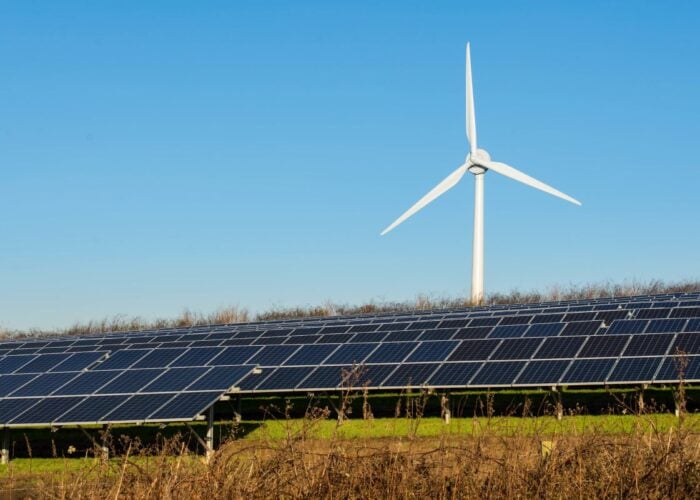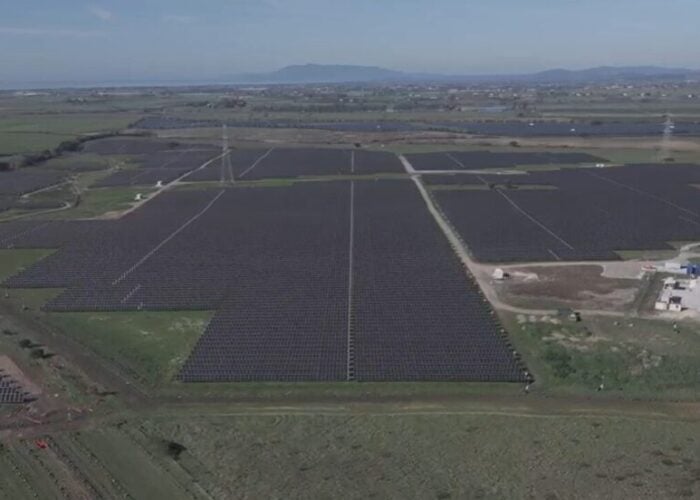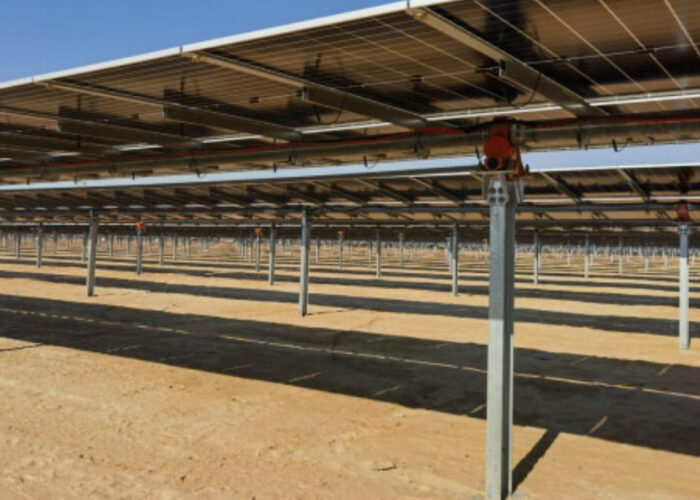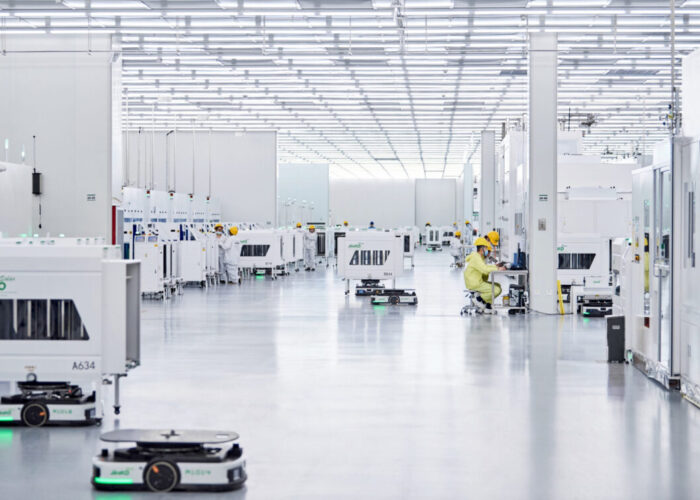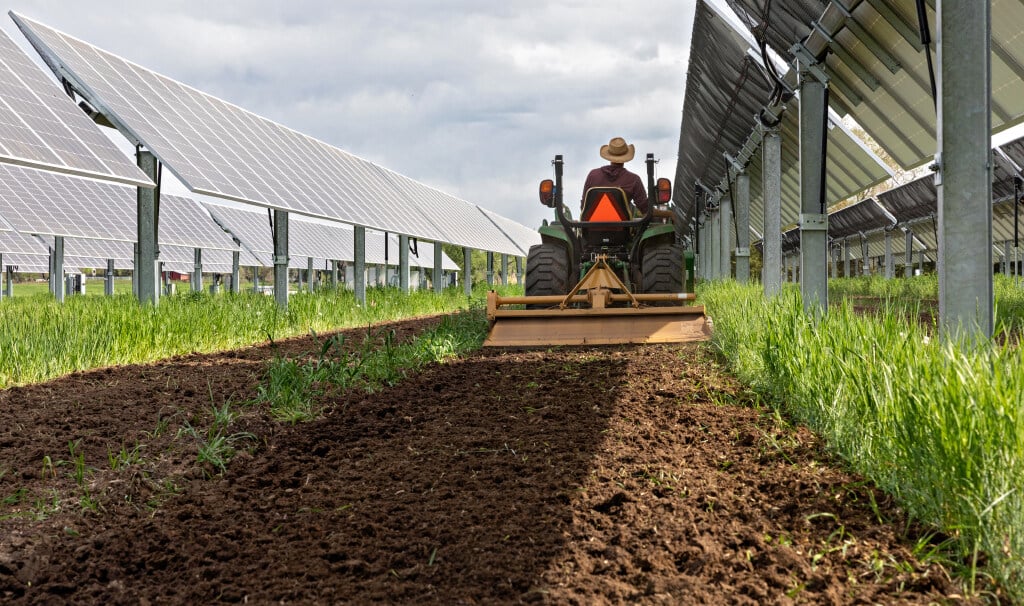
Combining solar plants with agriculture is becoming more prevalent in markets globally, increasing the availability of sites for new PV projects while reducing land-use conflicts. Will Norman details how the industry can take advantage of agrivoltaics opportunities while navigating construction, operation and maintenance challenges.
Unlock unlimited access for 12 whole months of distinctive global analysis
Photovoltaics International is now included.
- Regular insight and analysis of the industry’s biggest developments
- In-depth interviews with the industry’s leading figures
- Unlimited digital access to the PV Tech Power journal catalogue
- Unlimited digital access to the Photovoltaics International journal catalogue
- Access to more than 1,000 technical papers
- Discounts on Solar Media’s portfolio of events, in-person and virtual
Farming and solar power compete for two central resources – flat land and sunlight. Agrivoltaics (also known as agriPV, dual-use solar or agrisolar) is the practice of pairing solar PV operations with agriculture in the same location, be it crop cultivation, fruit farming, grazing livestock or providing habitats for pollinators. Panels can be placed alongside or suspended above farming operations, or incorporated vertically into fencing or integrated into greenhouses or shadings for soft fruit.
As well as resource competition, farming and solar seem regularly to inspire cultural and social opposition and debate. Ex-UK prime minister Liz Truss described solar panels as ‘paraphernalia’ last year as discussion arose about farmland deployments, and the US’ largest PV project – the Mammoth solar park in Indiana – received fervent backlash and resistance from a group of residents who opposed the use of farmland for solar plants. One particularly put-out woman bought the office next door to the developers’ and pasted the windows with homemade anti-solar posters.
Nevertheless, countries around the world have put money into supporting research and incentivising deployment of agrivoltaics, and solar developers and engineering, procurement and construction (EPC) contractors are increasingly factoring it in as a way to open up more sites and foster more positive relationships with the communities where they operate. Beyond the immediate interests of the PV industry, the dual concerns of two of the most pressing industries for global climate change – renewable energy and sustainable agriculture – converge in an agrivoltaics plant.
Land use
“This industry is going to be responsible for millions of acres of land over the next 10 years and we have a responsibility to maintain that land, if not improve it for future generations,” Matt Beasley, chief commercial officer at US solar PV developer Silicon Ranch, which focuses on regenerative agrivoltaics projects, tells PV Tech Power.
According to a paper published by the US National Renewable Energy Laboratory (NREL), ground-mounted utility-scale solar requires between 3-10 acres per MWdc of generation capacity and will need up to 11 million acres of land in the US alone by 2050. Farmland is often the most desirable and suitable for PV installations, as it’s generally flat, predictable and accessible.
Annie Rabi Bernard, an analyst for research and consultancy group Wood Mackenzie, speaks of the importance of dual land use for meeting deployment targets: “For countries like India, China, US, and regions in Europe that are keen on achieving higher electricity production through solar energy, deploying solar would be a requirement throughout the country. In these countries specifically, the vast landmass already used as cultivable land could be a market for implementing solar energy harvesting.”
According to the World Bank, around 44% of the land in the US is designated agricultural land, whilst Germany has 47% and India 60%. These countries have huge PV deployment targets that will require significant annual capacity expansions and acres upon acres of land. Germany is targeting 215GW of installed PV capacity by 2030, whilst India is aiming for 300GW by that date. The majority of these targets will be met by ground-mount utility-scale projects.
Land is a central resource for the development of PV projects – it’s also finite. The scale at which the industry is set to grow over the next two decades will see it needing an ever-bigger portion of the world’s habitable land, of which some figures say that 50% is currently taken up by agriculture.
As per Annie Rabi Bernard’s analysis, considering the utility of agricultural land proposes a market opportunity and could open up significantly more sites for PV developers. Beasley says that “the biggest challenge for the solar industry in the foreseeable future is land use”, and indicated the necessity for a shift in focus, for the industry to consider land efficiency and ease of deployment as a metric of value similar to energy output or capacity.
Jordan Macknick, lead energy-waterland analyst for NREL, echoes the sentiment: “One of the reasons I think developers are excited about the potential of agrivoltaics is that it reduces the barriers to deployment.” This applies both in terms of the sheer quantity of land available and the attractiveness for communities of paired systems in comparison with standalone PV.
The potential for deployment on this land raises environmental, social and governance (ESG) concerns, however, both in terms of the moral and ethical imperatives for developers to maintain the integrity of agricultural partners and the land itself and in terms of the long-term advantages of shoring up relationships and longevity within communities.
“One of the subjects not being discussed enough in our industry is the ability for solar companies to maintain a social license to operate,” Beasley says. [Agrivoltaics] is a clear way for us to demonstrate to our partners, customers and most importantly our neighbours that we are doing just that.”
Though the examples of nimbyism mentioned at the start of this article are of course excessive, solar developers do have a responsibility to the communities and the land where they choose to install projects. This is relatively commonly accepted, but as the global footprint of solar grows the need for partnership and collaboration between power producers and other industries and communities will grow too.
That sort of collaboration is inherent in the concept of dual land use, where PV deployment and profits can coexist with rural communities and continued farming practices. Macknick says: “There’s a clear financial incentive for farmers to adopt solar on their land, but we all need to eat, we all want to have a strong rural economy and rural producers, and people take a lot of pride in farming. So there’s this trade-off of these financial values versus cultural and social values.”
Not only is it socially necessary for PV developers to work with communities and prioritise both financial and cultural values, it’s also advantageous. In instances where pushback from communities threatens to slow projects down, agrivoltaics can provide a balancing factor to aid deployment.
‘We have a responsibility to be stewards of the land’: Silicon Ranch pairs regenerative agriculture with PV
Silicon Ranch owns and operates all of its solar PV installations, many of which are paired with either crops or livestock. Its 68MWac Houston Ranch project in the US state of Georgia – part of a larger collaboration between Silicon Ranch and Green Power EMC – is co-located with grazing sheep.
The project is part of the company’s Regenerative Energy programme, which focuses on regenerative agriculture on its PV sites to maintain landscapes, ecosystems and agricultural practices and communities.
The company’s relationship with agrivoltaics began in 2018. “We were in the early project development phase in South Georgia where our neighbour just so happened to be Will Harris of White Oak Pastures, one of the leading regenerative ranchers in the world,” says Matt Beasley, chief commercial officer at Silicon Ranch.
“After our CEO Reagan Farr and I met with Will and his family, we returned to Nashville and thoroughly investigated what it would take to transform the way we manage our lands.
“The entire experience was an epiphany for us, as we all began to realise we have an opportunity to view our land as a biological asset rather than as a liability, and moreover, we have a responsibility to be stewards of the land we occupy.”
The company said that from summer 2023 the Houston Ranch project will be home to a flock of 1,200 sheep and host a sheep breeding facility. Silicon Ranch claims to have “the largest flock of sheep owned by a renewable energy company in the US”.
Macknick says that NREL, one of the bodies leading agrivoltaics research in the US through its Department of Energyfunded InSPIRE programme, has seen agrivoltaics being used to make solar projects more appealing where communities have opposed development.
Steven Pleging, business development Netherlands at EPC Belectric, describes similar positive outcomes from its agrivoltaics operations: “Everywhere we or our partners are talking to permitting parties or influencers they see this as a kind of breakthrough in thinking.”
Mutual benefits
Macro concerns aside, agrivoltaics can provide benefits on a project-by-project basis. In terms of crop production, introducing PV modules to a cultivated area can provide shade and reduce wind exposure. Soft fruits or berries, for example, benefit from partial shading and protection from adverse elements, whilst strong wind can also prove an impediment to grass growth.
The fundamental competition in these sorts of installations is between photovoltaics and photosynthesis. Annie Rabi Bernard of Wood Mackenzie says: “Agricultural lands that cultivate crops that necessitate shading or thrive better/best under indirect sunlight are huge markets for agrivoltaics.” On the flip side, crops like wheat or others that require high-intensity, consistent sunlight may prove more difficult for agrivoltaics installations.
She continues: “Land used for fruit production and fruit crops is typically covered by plastics or hail nets, which could now be replaced by solar panels.”
Rabi Bernard says that a study testing agrivoltaics installations on grape farms in India showed that revenues had the potential to increase over 15 times with the addition of PV modules to the farming process, whilst yielding a consistent grape crop. The same research indicated that “implementing agrivoltaics across the country in similar farming land could potentially generate 16,000 GWh of electricity”.
There are also benefits that are not specifically economic, in terms of cultivating ecosystems and pollinator habitats, preventing soil or landscape erosion and providing irrigation and shading to desert areas. Citing an NREL project in Arizona – a notoriously harsh and dry climate – Jordan Macknick says that “under the partial shade and the solar panels we got double the yields of our tomatoes using 30% less water. And so you know that’s great, it essentially creates new harvestable land.
“There’s definite aspects of climate resilience here and resilience against extreme weathers and heatwaves and droughts that agrivoltaics can provide.”
Simultaneously, research has shown that thriving plant life underneath solar panels can improve energy efficiency per module. Plants release water vapours into the atmosphere through transpiration, which can then cool the panels from below and regulate their temperature, leading to more stable performance and efficiency.
Agrivoltaics’ role in food security for local communities
In terms of food security and distributed solar access, agrivoltaics could play a role in local communities.
Food security is defined by the World Bank as “when all people, at all times, have physical and economic access to sufficient safe and nutritious food”. Whilst far broader, far more complicated and systemic factors lie at the root of food insecurity, there are two metrics by which agrivoltaics could provide a valuable solution to these concerns.
Research from the National Renewable Energy Laboratory in the US showed that PV arrays can provide shade and water conservation in desert or arid landscapes, which can be a stimulus to crop growth. It also found that installing a PV array in arid areas of northern India required the same amount of water as was needed to sustain an aloe vera plantation, suggesting the possibility of integrating the two systems.
Agrivoltaics also has the potential to be paired with community solar – a term used to denote small-scale solar installations that serve a local community, often off-grid – to support local communities by reaping the most sustainable value from a given piece of land.
US company Lightstar, for example, develops community agrivoltaics projects that work with local landowners and farmers to generate dual land-use installations, enabling the two economies, systems and resources to co-exist to benefit the community.
Regarding grazing livestock, despite seeming as though they create unpredictable hazards, grazing animals can provide operations and maintenance (O&M) benefits for plant operators and farmers. Silicon Ranch senior vice president for technology and asset management Nick de Vries says: “Sheep pose way less of a risk of damage to cables than any mower, but they do come with fences, water, which everyone on site has to be aware of.”
Grazing sheep or cattle can also maintain grass height, preventing it from growing and shading the modules, and animals can help with biodiversity and soil quality that may otherwise suffer under a standalone PV installation.
Project construction considerations
In terms of EPC, “to implement agrivoltaics, it is important to think holistically about the project by first carefully observing the land and being ready to adjust to changing conditions”, says Matt Beasley of Silicon Ranch. Considerations like panel height, spacing, protection from animals or farming equipment, irrigation and fencing are all project-specific and require consideration from an EPC standpoint, and will change depending on the requirements of the specific crop.
However, Johannes Linder, head of system design and innovation at Belectric, says that in Germany the company has focused on using tracker systems installed beside crops, rather than the more eye-catching and expensive raised panels often associated with agrivoltaics. He suggests that standardisation is possible in this configuration.
“The difference in the construction of those kinds of power plants is not too big [compared with standard projects],” he says. “You have to involve the farmer in the planning, but overall the story is that it’s a standard technology which can be used and does not drive the prices too high.”
This isn’t always the case with all technologies, however. Speaking about the US market, Jordan Macknick says that NREL has observed some pushback on a cost basis from solar developers regarding large-scale projects paired with crop farming.
“Jack’s Solar Garden, one of our research sites, has panels that are elevated to a much higher height than what you’d normally see for utility-scale solar, something that allows humans and equipment access, that allows for more sunlight, allows us to get higher yields in our crops,” Macknick says.
“But steel is expensive. The solar industry, I think, is not as interested in these larger projects that involve a lot more steel, because it makes them very expensive and less cost competitive.”
As you scale size, so you scale cost when it comes to expensive raw materials like steel. This can cause a problem for utility-scale developers, as greater spacing and accommodation for crops, tractors, irrigation and other sundries often means that, coupled with higher installation and material costs, they see less return on each electron they produce.
Government support and the future for agrivoltaics
Support schemes for agrivoltaics have emerged across the world. In August 2022, the Italian Ministry of Agricultural, Food and Forestry Policies announced a US$1.5 billion scheme to incentivise agrivoltaics installations across the country. It said that the programme could add 375MW of solar across Italy in crop and livestock deployments through providing direct grants that can cover up to 90% of eligible projects’ costs.
Germany introduced a scheme in February 2022 to accelerate deployment of PV on agricultural land through its Renewable Energy Act, opening up agricultural moorland in particular for PV deployment as long as land maintenance and restoration requirements are met. This announcement was lauded by trade associations which saw the new land opportunities as central to the country’s ability to achieve its 2030 target of reaching 215GW of installed solar.
In India, the Central Arid Zone Research Institute has been conducting operations on agrivoltaics test locations, though the technology is still in its infancy there and any central collaboration or incentives are yet to take shape, according to research from consultancy Mercom Capital Group.
Of all markets, however, India has a lot of latent potential to develop agrivoltaics, according to Annie Rabi Bernard. “Regions that are highly invested and relying on agriculture (like India and Indian subcontinent, east Asian countries, west and east Africa) are prime markets for agrivoltaics,” she says.
“Many of these regions battle with unreliable farming techniques and are in dire need of practices like agrivoltaics which can make agriculture sustainable and reliable. In countries like India which are highly populated, the government is under stress to grow its GDP and proportionately increase its energy supply, which can be tackled with the practice of agrivoltaics.”
Turning westwards to the US, NREL has been running its InSPIRE programme (Innovative Solar Practices Integrated with Rural Economies and Ecosystems) since 2015, backed by the Department of Energy to research agrivoltaics deployments across the country.
Jordan Macknick is the lead researcher for the project and says that the US has seen around US$50 million in research and development funding from the federal government, the majority of which came from the Department of Energy with the rest made up by the Department of Agriculture.
“There’s only been one state in the United States that has offered a financial incentive for developing agrivoltaics,” he adds, “and that’s the state of Massachusetts in their SMART programme.”
Looking forward, then, Macknick sees agrivoltaics in the US growing, but with caveats. NREL maps out the different agrivoltaics sites across the US on its website, and the trends seem to be a concentration in the northeast and a large predominance in grazing and pollinator sites over crop production.
Large-scale sites in the US will be grazing sites or “ecosystem services” agrivoltaics, Macknick says, mostly because of the clearer and more researched O&M procedures. The industry better understands the execution and particularities of grazing or pollinator agrivoltaics pairings, but crop projects often have more nuance and can vary depending on the produce in question.
As with land use, Macknick says that the key to unlocking more crop-based agrivoltaics in the future will be communication and collaboration between the PV industry and farmers. “I don’t see there being a lot of agrivoltaics development in terms of crop production without a lot more engagement and interaction and partnerships between the solar industry and landowners and farming organisations.”
Belectric’s Steven Pleging says a similar thing of the Dutch market: “There’s still a lot to learn on which crops are actually most beneficial [for agrivoltaics]”, whilst production on dairy farms in the Netherlands has proved fruitful for Belectric. The story is not entirely the same across Europe, however, as Linder says that the company focuses on crop production sites in Germany, and existing projects in Italy and elsewhere often feature crop production.
Macknick says that in the US projects are designed with a view to energy efficiency as the main metric of success, whilst in Europe a more collaborative approach prioritising agricultural benefit has been seen.
When asked if NREL has seen much splitting of revenue generated from the land between solar developers and farmers, Macknick says: “No. It’s a great idea, It can make a lot of sense, but it’s not something we’ve seen frequently.” This practice could perhaps make crop production more viable on a large scale, as shared value could offset higher costs or lower production in each field as well as shoring up relations and security in the agricultural sector.
The rise of agrivoltaics has been a confluence of the industry’s sustainable aspirations and the real market opportunity it presents. From both long-term land use and ESG perspectives, we can expect it to become more and more common. Some resistance or impediments may remain, be they cost or immediate scaleability, but as with most technological developments the need for implementation will doubtless see the industry find ways to proceed.
Annie Rabi Bernard says: “Overall, agrivoltaics is largely seen positively as a highly flexible initiative, an innovative compromise to solve land-use conflicts and a welcomed contribution to the green transition.”

